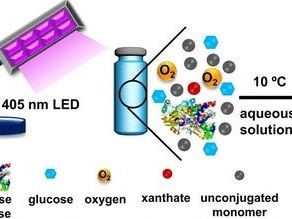Navigable Nanotransport
Direct synthesis of hollow nanoscopic spheres with tailored surfaces
Advertisement
To accurately transport pharmaceutical agents to their specific target organs or cell types, you need a good carrier: nanoscopic capsules with surface elements that can "recognize" the target in question could do the trick. To date, all methods for the production of such tiny capsules require preorganized structures or "molds" to shape hollow spheres and most methods require a lengthy, tedious synthetic or purification procedure. Korean researchers led by Kimoon Kim have now developed a very simple novel approach for the direct production of polymeric nanocapsules. This method is generally applicable to any monomers as long as they have a flat core and multiple polymerizable groups at the periphery. Additionally, if building block are chosen that are able to bind specific (bio)molecules very tightly, the surface of the capsule can be easily decorated with species that are recognized by cells, showing the transporter the way to reach its goal, such as a tumor cell.
To demonstrate the power of their new concept, Kim and his team chose rigid, disk-shaped monomers equipped with a ring of special molecular "hooks" that can be activated by UV light. When a solution containing these disks is irradiated, the hooks grab on to each other, linking the disks into little, two-dimensional "patches" that in turn hook on to other patches. Once they reach a certain size, the patches bend around and close off to form hollow spheres, which can then be filled with guest molecules. The size of the spheres is very uniform and depends largely on the solvent in which the linking reaction takes place. The researchers used this method to produce capsules with diameters ranging from 50 to 600 nm.
The little disks used in this process deserve special consideration: Kim and his colleagues chose to use curcurbiturils. These disk-shaped molecules have a cavity at their center. As their shape resembles a hollowed-out pumpkin, this class of compounds was named after the plant genus of pumpkins, the cucurbitaceae. When the mini-pumpkins are linked together, they form an empty sphere with many tiny cavities on its surface. These "pockets" can be filled with certain nitrogen-containing biomolecules, such as spermine, in a very stable fashion.
The Korean researchers coupled spermine to the vitamin folic acid and packed these hybrid molecules into the capsule's pockets. This gave them capsules with a surface covered with folic acid molecules. Many tumors have a significantly increased number of folic acid receptors on the surfaces of their cells. The folic acid on the capsules docks into these sites and is brought into the interior of the cell. Here, the contents of the capsule, such as an antitumor drug or contrast agent, can be released to selectively attack the tumor or to make an unambiguous diagnosis.
Original publication: Kimoon Kim et al.; "Direct Synthesis of Polymer Nanocapsules with a Noncovalently Tailorable Surface"; Angewandte Chemie International Edition 2006.
Other news from the department science
Most read news
More news from our other portals
See the theme worlds for related content
Topic world Synthesis
Chemical synthesis is at the heart of modern chemistry and enables the targeted production of molecules with specific properties. By combining starting materials in defined reaction conditions, chemists can create a wide range of compounds, from simple molecules to complex active ingredients.

Topic world Synthesis
Chemical synthesis is at the heart of modern chemistry and enables the targeted production of molecules with specific properties. By combining starting materials in defined reaction conditions, chemists can create a wide range of compounds, from simple molecules to complex active ingredients.





























































